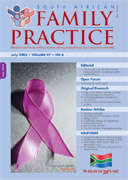CPD: Acute Bacterial Rhinosinusitis in Adults: Part I. Evaluation.
Abstract
Acute rhinosinusitis is one of the most common conditions that physicians treat in ambulatory practice. Although often caused by viruses, it sometimes is caused by bacteria, a condition that is called acute bacterial rhinosinusitis. The signs and symptoms of acute bacterial rhinosinusitis and prolonged viral upper respiratory infection are similar, which makes accurate clinical diagnosis difficult. Because two thirds of patients with acute bacterial rhinosinusitis improve without antibiotic treatment and most patients with viral upper respiratory infection improve within seven days, antibiotic therapy should be reserved for use in patients who have had symptoms for more than seven days and meet clinical criteria. Four signs and symptoms are the most helpful in predicting acute bacterial rhinosinusitis: purulent nasal discharge, maxillary tooth or facial pain (especially unilateral), unilateral maxillary sinus tenderness, and worsening symptoms after initial improvement. Sinus radiography and ultrasonography are not recommended in the diagnosis of uncomplicated acute bacterial rhinosinusitis, although computed tomography has a role in the care of patients with recurrent or chronic symptoms. (SA Fam Pract 2005;47(6): 22-26) (Reprinted from: Am Fam Physician 2004;70:1685-92. Copyright© 2004 American Academy of Family Physicians.) Permission from the AAFP was granted to publish this article in the hardcopy only. Kindly refer to www.aafp.org or subscribe to the hardcopy of South African Family Practice.
Published
2005-07-01
Issue
Section
Review Articles
By submitting manuscripts to SAFP, authors of original articles are assigning copyright to the South African Academy of Family Physicians. Copyright of review articles are assigned to the Publisher, Medpharm Publications (Pty) Ltd, unless otherwise specified. Authors may use their own work after publication without written permission, provided they acknowledge the original source. Individuals and academic institutions may freely copy and distribute articles published in SAFP for educational and research purposes without obtaining permission.

